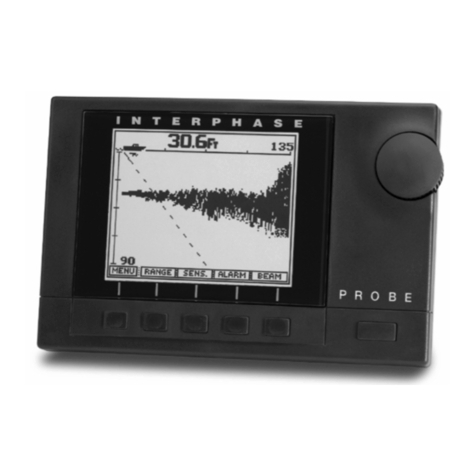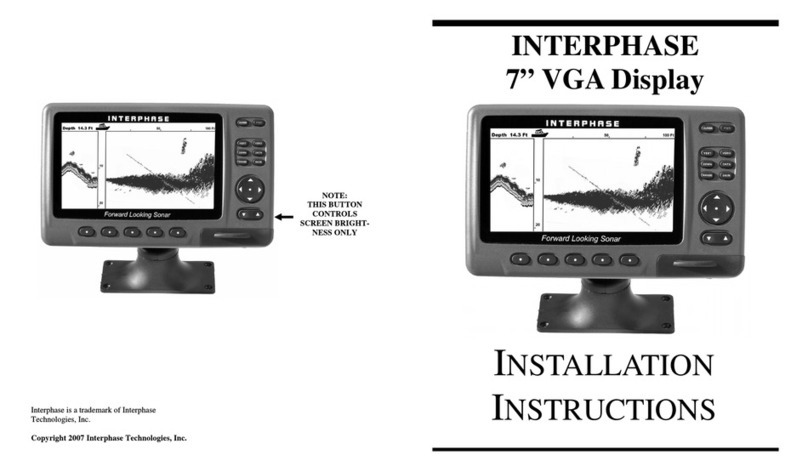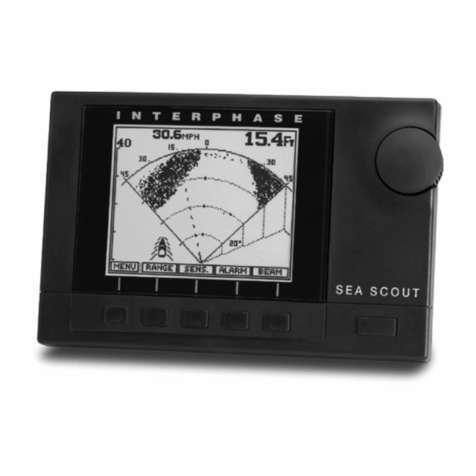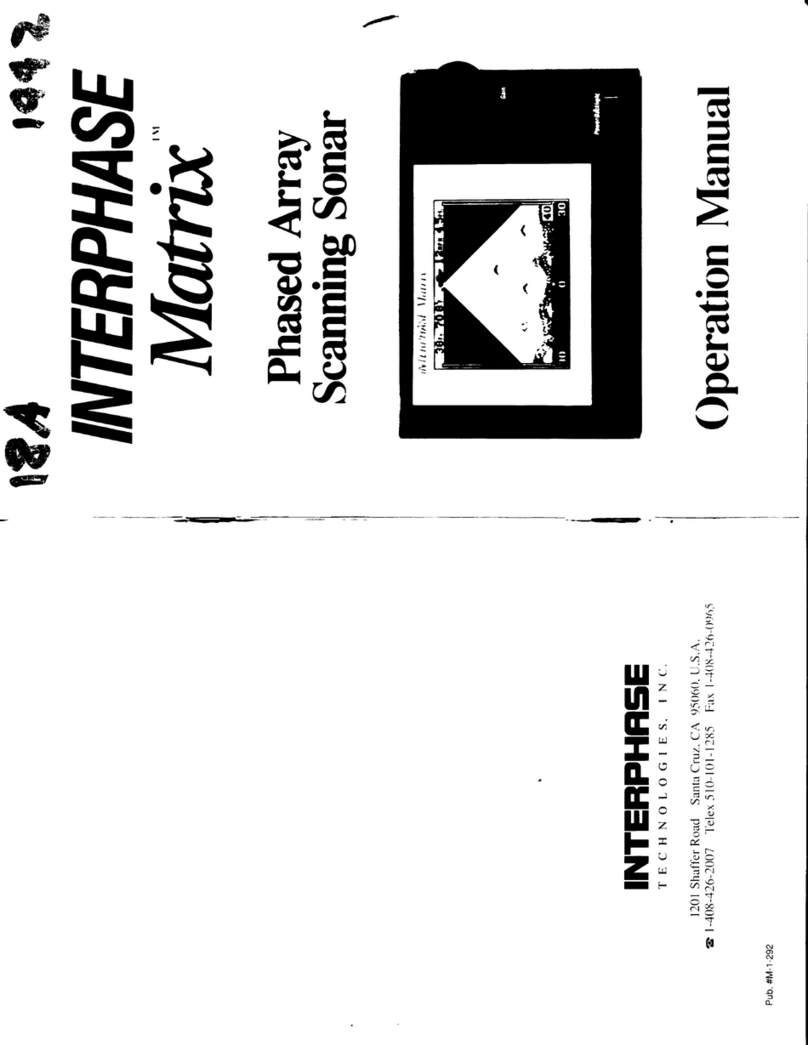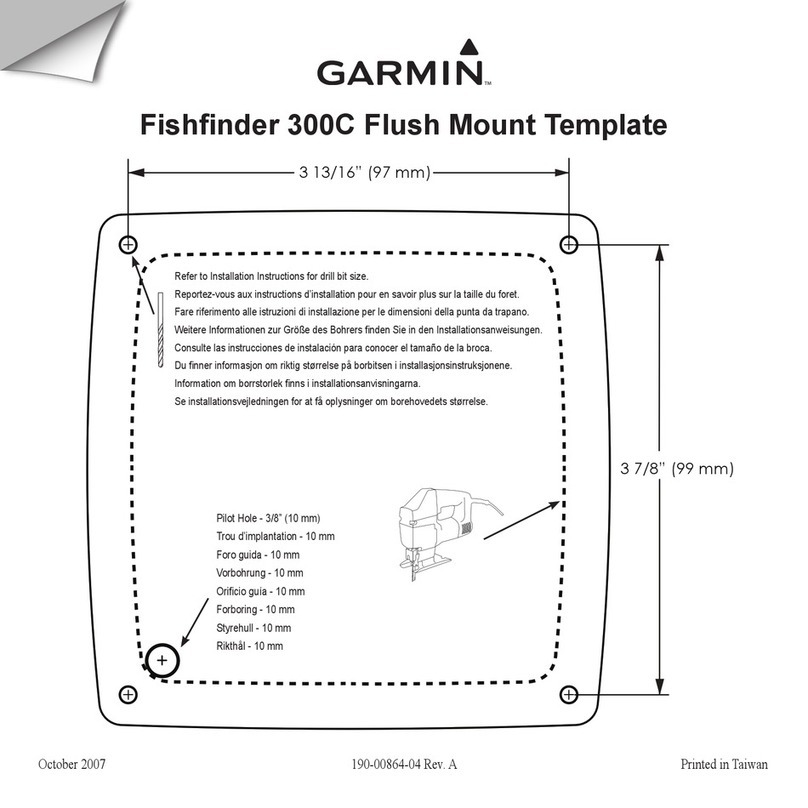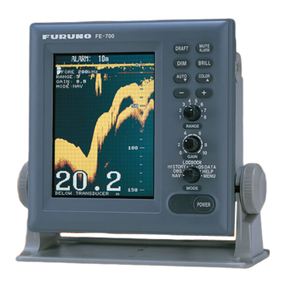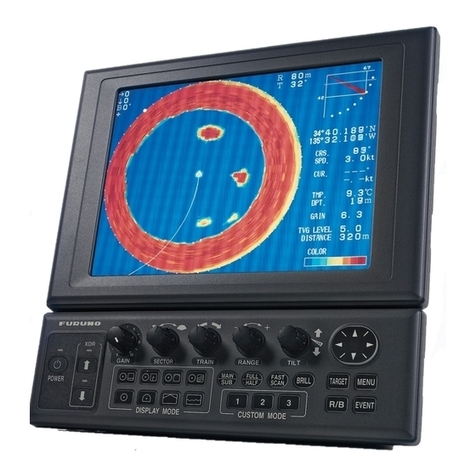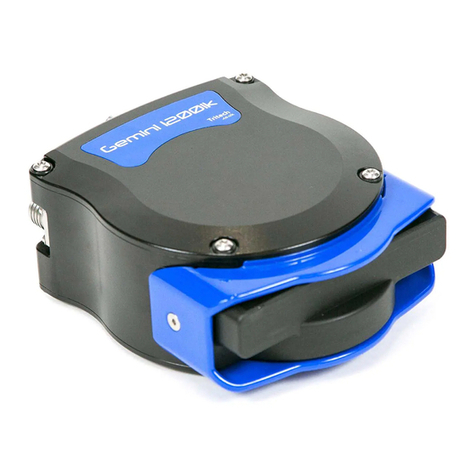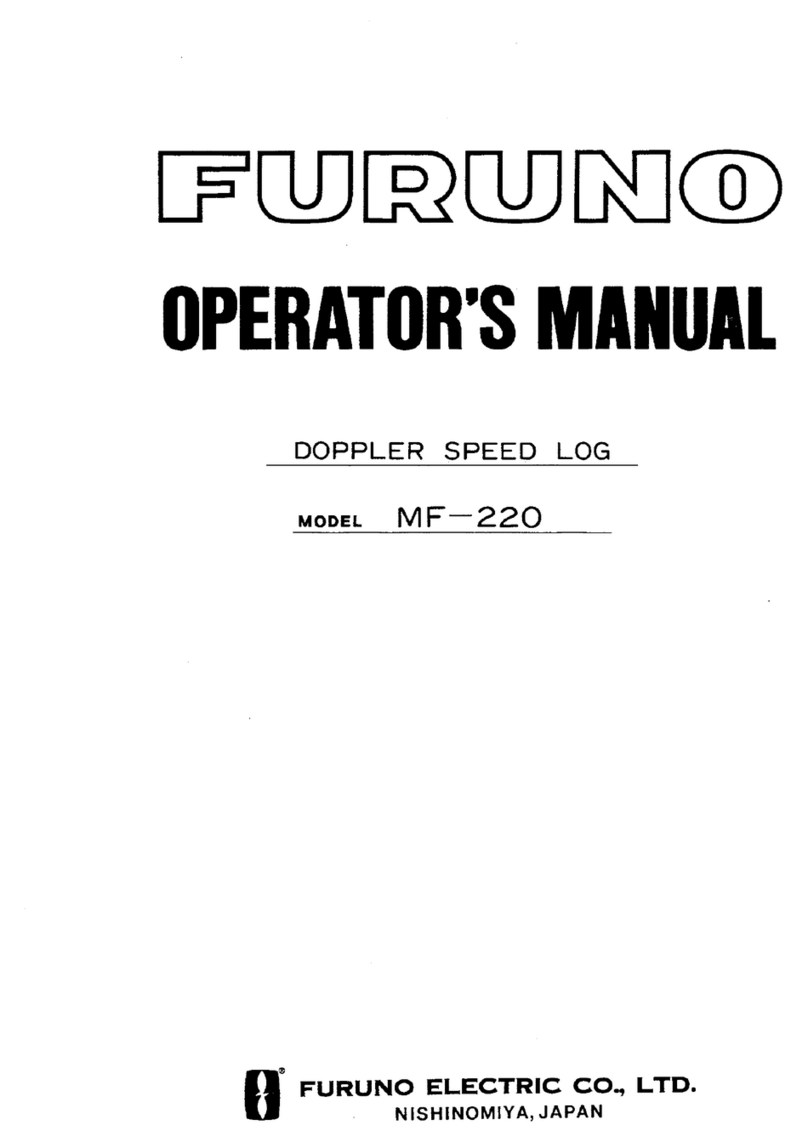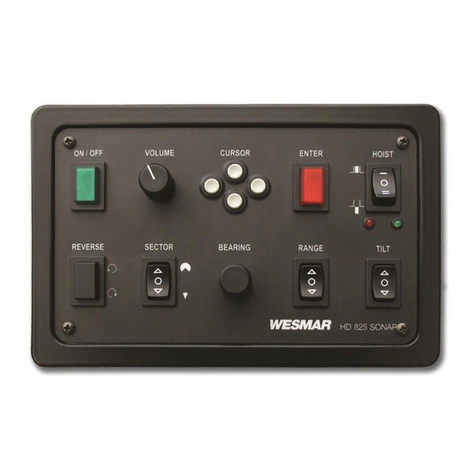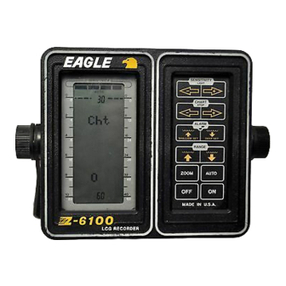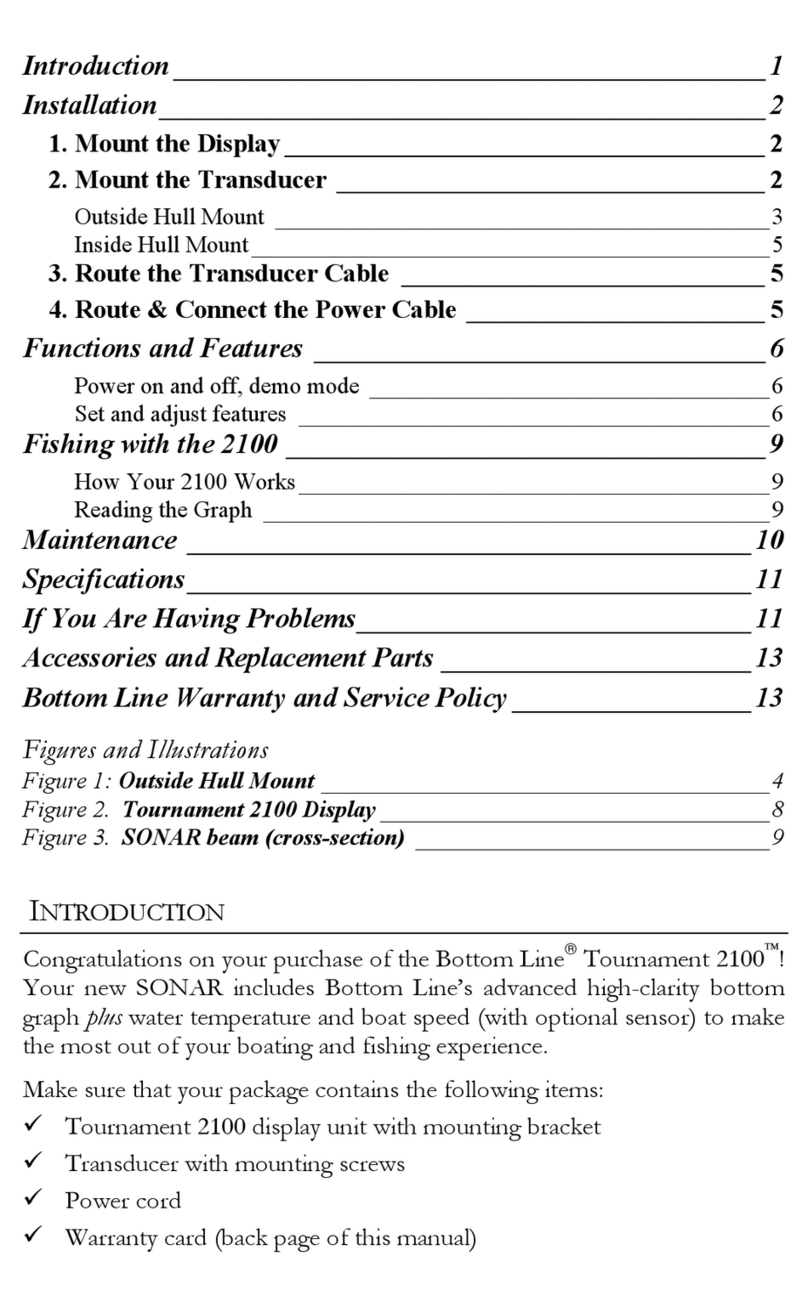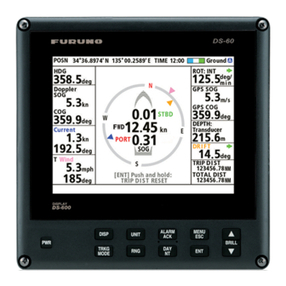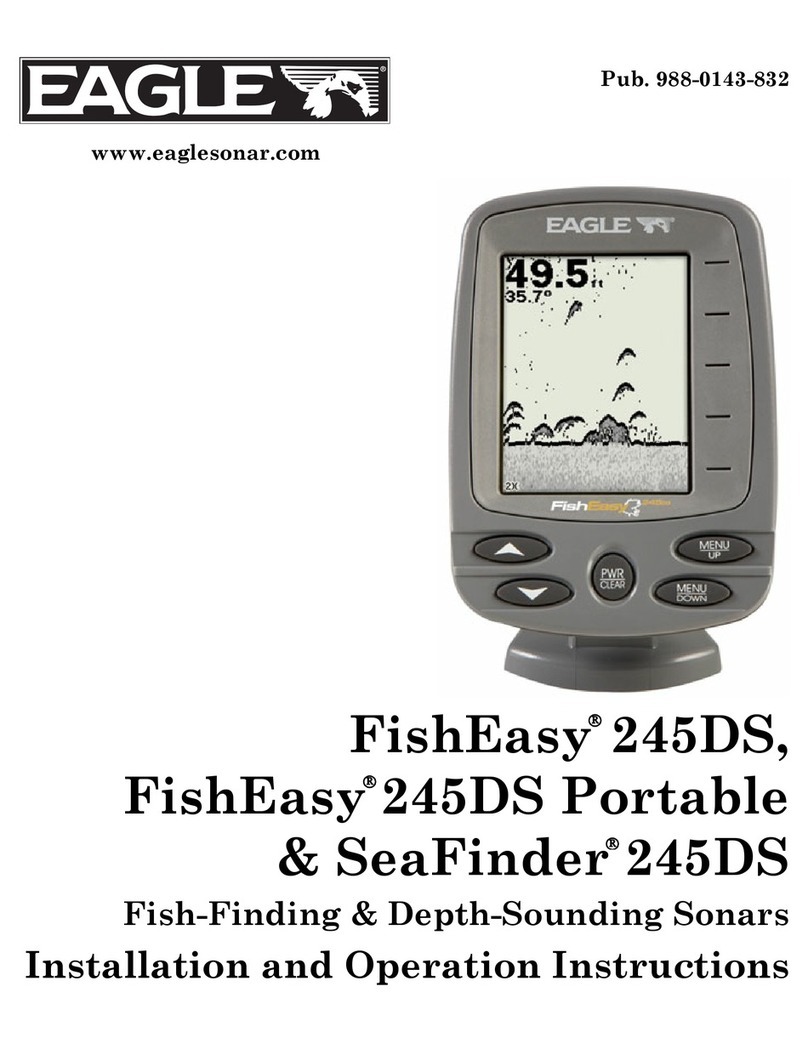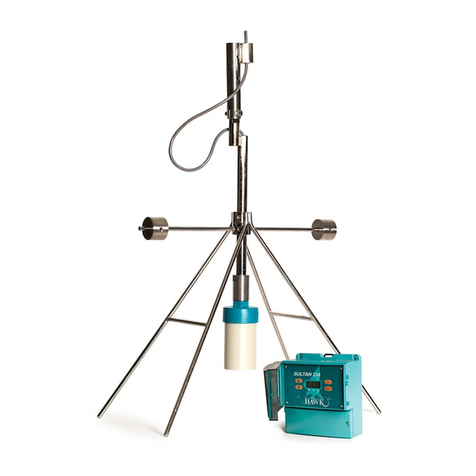Interphase Color Twinscope User manual

1

2
To Our Customer:
Thank you for choosing the Interphase Color Twinscope Dual-Axis Forward Scanning
Sonar. Throughout the development of this product, we have tried to make sure that we
included all of the suggestions made by owners of our earlier sonar models. Selection of
features, ease of use, superior performance and outstanding reliability were the benchmarks
upon which all important design decisions were made. We feel proud of the Color Twinscope
and your satisfaction is very important to us. To this end, we welcome any comments or
suggestions that you might have in regard to this equipment.
It is very important that you complete and return the WARRANTY REGISTRATION
CARD within 15 days of purchase so that we have a record of your purchase, both to protect
your warranty and to allow us a method to contact you about future enhancements, etc.
Sincerely,
INTERPHASE TECHNOLOGIES, INC.
2880 Research Park Drive, #140
Soquel, CA 95073
Phone: (831) 477-4944
Fax: (831) 462-7444
Email: comments@interphase-tech.com
Website: www.interphase-tech.com
©2005 Interphase Technologies, Inc.
Interphase Color Twinscope™ is a trademark of Interphase Technologies, Inc.
Publication # = Color Twinscope 1.6

3
Table Of Contents
Important Notice 4
Principle of Operation 5
Display Unit Installation 6
Transducer Selection and Installation 8
Getting Started 18
Display Colors 19
Set-Up 20
Languages/Units 20
More (Max Gain, Remote/ Master) 20
STC Adjustment__________________________________________________________ 21
Transducer Adjustments 22
Demo 22
System Reset_____________________________________________________________22
Displays 23
Vertical 23
Horizontal 23
Down 24
Down Zoom 24
Data 25
Operating Adjustments 26
Range 26
Gain 26
Screen Cursor 27
Scanning Speed 28
Alarm Adjustment 28
Beam Adjustment 28
Video Input 29
Interpreting the Vertical Display 30
Interpreting the Horizontal Display 32
Inputs and Outputs 34
Video Inputs 34
External Alarm 34
NMEA inputs (GPS, Temp) / NMEA Depth Output 35
Remote Displays (2nd Stations) 36
Software Upgrades 37
Maintenance 38
Trouble Shooting Tips 38
Interference Problems 39
Specifications 40
How to Obtain Service 41
Warranty 43

4
General Information
Thank you for your selection of the Interphase Color
Twinscope Forward Scanning Sonar. The Color Twinscope’s
ruggedly built, compact design makes it ideal for installation
on nearly any boat. It will display water depth, bottom
conditions and submerged objects such as fish, or objects in
your path, on its high resolution display. The Color
Twinscope is available with either a thru-hull or two transom-
mount scanning sonar depth transducers.
To ensure that you receive the maximum benefits available
from the outstanding features of the Interphase Color
Twinscope, please carefully follow the steps outlined in this
manual. An instructive demonstration simulator has been
designed into the Color Twinscope and we highly recommend
that you spend some time using the demo mode prior to actual
use of the unit. We also recommend that you read this entire
manual before attempting to either install or operate your
Color Twinscope.
Warranty Information
Interphase provides a limited warranty on the Color
Twinscope Forward Scanning Sonar which is printed on the
inside rear cover of this manual. We recommend that you save
all packing materials so that if you should need to send the unit
in for repair, it can be fully protected. Should you experience
a problem with your Color Twinscope, first refer to the
Troubleshooting section (Page 38) of this manual. Most
common problems and their solutions are described here. If
problems persist, call Interphase Product Support at (831)
477-4944. We will be happy to try to assist you, and if
required, we will give you instructions on how to quickly get
your set repaired.
The enclosed warranty registration card must be completed
and returned to Interphase within 15 days of purchase so that
your unit may be protected under the warranty. Failure to
return the warranty card may cause unnecessary delays in
processing your unit for warranty repair. (See warranty, page
43).
WARNING
Navigation based solely on one method or
one instrument should never be practiced.
While the Color Twinscope can be quite
useful in showing underwater structure and
changing bottom conditions both below and
in front of your vessel, there are many
situations and conditions which can cause
erroneous or distorted readings.
In addition, there are many situations that
can cause “blind spots” in the Color
Twinscope’s field of view including the
presence of temperature inversion layers
(thermoclines), water turbulence, and high
concentrations of suspended particles in the
water.
While the Color Twinscope can be
considered as a useful aid to navigation, it
should never be the only means of
navigation.

5
Principle of Operation
The Color Twinscope Forward Scanning Sonar uses a
proprietary and patented phased array acoustic technology first
developed for marine use by Interphase Technologies.
Known as “phased array ultrasound technology”, its
capabilities have been proven in the military and medical
industries for many years. The amazing video images
provided by medical ultrasound equipment are familiar to most
people and clearly demonstrate the technology’s ability to
show highly defined images in a "real time" or "live action"
mode.
Interphase’s phased array is a group of piezoelectric ceramic
elements that are precisely sized and spaced. Each element
can send and receive acoustic pulses. When all elements in the
array are sending or receiving acoustic energy at the same
time, the entire array behaves like a single larger element with
one important difference: the ability of the array to concentrate
its acoustic energy in different directions, depending on the
different “phasing” of the signals applied or received by each
element. Depending on the signal phasing of the array,
acoustic beams can be directed in an almost unlimited number
of directions. For example, using an 8 element phased array
transducer, the COLOR TWINSCOPE is capable of steering
the acoustic beam in any of 60 different directions.
Since the acoustic beam in the phased array is steered
electronically, requiring no moving parts, it can be quickly and
reliably scanned and re-scanned over a large area. When
displayed, the changing information between subsequent scans
takes on an almost animated quality - for example, showing
movement of underwater targets such as fish or rapidly
changing bottom conditions.
During operation, the Color Twinscope converts a small
amount of electrical current from your battery into ultrasonic
sound pulses, which are then fed to the phased array
transducer. These acoustic pulses travel out from the
transducer in a cone shaped pattern, called the cone angle.
When the sound pulse strikes an underwater object, it is
reflected back (echo return), received by the transducer and
converted back into small electrical impulses. These impulses
are amplified, then displayed as an image on the LCD screen.
Award Winning
Technology
For its pioneering work in
developing Phased Array
Scanning Sonar,
Interphase Technologies
won the prestigious
IMTEC INNOVATION
AWARD.
The Color Twinscope is
based on this same award-
winning technology.

6
Installation
Display Unit
The compact size of the Color Twinscope display unit allows
for easy installation in almost any vessel. To get maximum
performance and life from your unit, the following guidelines
should be considered when selecting a mounting location:
1) Select a location where the unit is protected from excessive
temperatures. Heat is one of the worst enemies of electronic
components, and will accelerate component aging, thereby
reducing the trouble-free life of your Color Twinscope.
2) Mount the display in a location where it will be convenient
to route the power cord and transducer cable.
Power connection
The Color Twinscope’s power leads are the red and black
wires inside the cable that connects to the rear mount. These
wires must be connected to a source of 12VDC voltage. The
red wire should connect to the plus (+) 12 VDC and the black
wire should be connected to the minus (-) side of the 12 VDC.
To minimize electrical interference, carefully route the power
cable so that it does not run parallel or close to the transducer
cable, engine, refrigeration, bilge pump or any other critical
wiring. An in-line fuse holder is included with your unit and
should be placed in the positive lead as shown at left. A 2
Amp fuse is included.
IMPORTANT: The Color Twinscope’s 12 VDC power leads
should go directly to the boat’s battery, distribution board, or
breaker panel. Instability of the display may result if the unit
has to share leads with other electrical systems aboard your
boat.
Wiring for Power & Transducer Connectors
The correct pin-out wiring sequences for the transducer
connectors are shown at right. DO NOT SHORTEN THE
TRANSDUCER CABLES. If a transducer cable longer than
the 30’ length supplied with your unit is needed, please contact
your Interphase dealer. 30-foot scanning sonar transducer
extension cables are available. (P/N 04-0014-008)
DANGER: Removal of any connector, disassembly of
transducer, shortening of any cable or use of any cable other
than that supplied by Interphase will void your warranty.
(-) (+)
12 VDC
Color Twinscope Rear Panel Connections
Horizontal
Scanning Input
(Blue Nut)
Vertical
Scanning Input
(Green Nut)
Power
and I/O
Cable
Video
Input
2 Amp
In-Line Fuse
Blac Red

7
In - Dash Mounting
The Color Twinscope comes with mounting hardware to
mount the display in-dash. Four mounting screws and a
cutout diagram are included.
For in-dash mounting, the mounting base portion of the
Quick Disconnect Mount is removed. To remove the
mounting base loosen the thumb screw until it seperates
from the upper portion of the Quick Disconnect Mount.
While the cutout is included, dimensions of the cutout and
pilot holes has been included in the drawing below.
Loosen to remove
8.3” [211mm]
8.7” [220mm]
3.9” [100mm]
5” [126mm

8
SINGLE THRU-HULL
(T1-I200-032)
TWO TRANSOM MOUNTS
TWO THRU-HULL'S
(T1-I200-026 - vertical)
(T1-I200-029 - horizontal)
(T1-I200-025 - vertical)
(T1-I200-028 - horizontal)
Wiring and Cable Connectors
9 Pin Transducer Connectors:
(view from front of female plug)
1 White 1st element
2 Brown 2nd element
3 Orange 3rd element
4 Yellow 4th element
5 Green 5th element
6 Blue 6th element
7 Violet 7th element
8 Gray 8th element
9 Shield Ground/Return
3 Pin Video Input
1 Ground Return
2 +12 VDC
3 Video Signal
Transducer Connectors
Color Coded. Blue = Horizontal and
Green = Vertical Scanning inputs
Main Power-I/O Wiring .
(Cable from Quick Disconnect Bracket)
WIRE
COLOR DESCRIPTION FUNCTION
BLACK GND/COMMON POWER SUPPLY GND (-)
RED POWER +11-16 VDC POWER SUPPLY (+)
WHITE RXA (+) GPS INPUT PORT
GREEN RX-TX - GND - SERIAL PORT(s) RETURN
YELLOW TXA (+) NMEA OUT/ MASTER-REMOTE/
SOFTWARE DOWNLOADS
BROWN RXC (+) NMEA TEMP INPUT PORT
GRAY +12 Vdc - OUTPUT 12VDC - FOR ALARM
ORANGE RXB (+) MASTER-REMOTE/SOFTWARE
DOWNLOADS
PINK TXB (+) N/C
BLUE TXC - OUTPUT 3+ EXTERNAL ALARM SIGNAL
QUICK DISCONNECT BRACKET CABLE
Thru-Hull or
Transom Mount
Transducers
Transducer Connections
1
2
3

9
Selecting the Transducer
Configuration for your Boat
Keep in mind the primary rule for transducer operation.
This is: the transducer can function as long as it has an
unobstructed forward view and has smooth flowing
non-aerated water surrounding it.
The first line of inquiry should be about the boat.
Transom mounted transducers are intended for low
speed boats with external props. Boats with inboard
motors and boats that regularly exceed 40MPH cannot
use transom mounted transducers. Inboard motors
create aeration and excess turbulence that prevent the
transducers from operating properly. I/O motors where
the prop is aft of the transom do not create this
situation. Be careful that the driveshaft of the I/O does
not block the forward horizontal scan. Boats that exceed
40MPH run a risk of having the transom mounted
transduers torn free of the transom. The transom
mounted transducers are not designed to be used at
these speeds.
In addition, the transom mounted transducers are
mounted on kick-up brackets. This allows the brackets
to kick up at about 35-40MPH. This is intended to
allow the transducers to kick-up if they strike an
object, or to be pulled up when trailering a boat. Once
kicked up, the transducers must be manully reset in
order to function.
Thru-hull transducers are for boats that exceed 40MPH
and /or have inboard motors. Transducer placement
depends on boat size, speed, hull configuration and
sonar application. On displacement hulls, the
transducer is generally located 1/3 aft of where the bow
meets the water line. This is the farthest forward the
transducer should ever be mounted. It is important that
the transducer be below turbulent aerated water created
by the bow.
Special Thru-Hull Mounting Considerations
On sailboats with a fin keel, the transducer is most often
placed at the leading edge of the keel and sometimes
faired into the keel. As this location may be where the
sling rests when hauling the boat, the
transducer may be placed on either side of the hull with
the foremost face of the transducer even with the
leading edge of the keel. Alternatley, the transducer may
be placed forward of the keel ahead of the lifting strap
location. This should not be ahead of 1/3 aft of where the
bow meets the waterline.
On planing hulls the transducer is typically placed near
the transom. This is to provide smooth flowing water at
the greastest speed. However, most planing hull boats
create transducer aeration when on plane regardless of
transducer location.
It should be noted that thru-hull transducers can effect
boat performance in two important ways. The first
concern is cavitation created by the transducer that causes
reduced engine performance by disrupting water flow
around the propeller. This is smoothed out by the hull in
some boats, but on planing hulls with the
transducer near the transom, the hull is not able to clear
the cavitation. The second concern is uneven drag on
high-speed boats. This may occur when the thru-hull
transducer is mounted far off of the centerline of the boat.
At low speeds and on large boats the effect is
negligible. On smaller boats at high speeds the drag can
effect the steering. The effect increases as the boat’s
speed rises. Boats with trim tabs can usually trim this out,
but boats without trim tabs may feel a pulling
sensation toward the transducer side of the boat.
A less intuative mounting location for the single thru-hull
transducer on a planing hull is on the centerline just
forward of midship. The goal in this mounting is to place
the transducer so that it is out of the water at planing
speed. As most transducers are aerated at planing speeds,
this removes the transducer from the water flow
preventing cavitation and steering problems. Most
applications for forward scanning sonar occur when the
boat is at low non-planing speeds including fishing and
navigating hazardous waters. Under these speed
conditions the transducer is in the water.
On trailered boats, be certain that the mounting is such
that the boat does not rest on the transducers. This could
result in damage to the transducer and/or boat hull.
Explore possible mounting locations while the boat is on
the trailer.

10
Special Note on the
Color Twinscope Transducers
Q: There are 2 types of thru-hull transducers for the
Color Twinscope, 1 with a single transducer and 1 with
dual transducers. What are the dual transducers for? Do
they provide an extra function for the display or is it to
offset a larger keel? Does a large keel affect the
horizontal sweep of the sonar (single or dual)?
A: Interphase offers the twin thru-hull transducers for
small high speed boats. The single thru-hull transducer
is nearly twice as wide as each of the dual thru-hulls. If
the boat does no allow an installation on or close to the
center line, then the transducer is sometimes placed
2-3 feet away from the center line. On a high speed boat
(40+MPH) the drag can be felt in the steering. If the
boat does not have trim tabs to trim this out, then the
boat can 'pull'to one side at high speeds. The dual
transducer configuration allows for a transducer on each
side of the hull which evens out the water flow across
the hull.
This does not account for the forward horizontal sweep
being blocked by a keel, or deep V hull. In order for the
forward horizontal scan to pass beneath the hull, the
angle between the transducer and lowest point on the
hull must be less than 10 degrees. If the keel or hull of
the boat will block the forward horizontal scan, then the
Interphase iScan 180 should be considered.
The Transom Mounted Transducer is designed
for boats with a top speed below 40MPH.
The Thru-hull Transducer is for boats that
EXCEED 40MPH and /or have inboard motors.

11
Transducer Installation
The Color Twinscope comes standard with either a single or
twin thru-hull or with two transom mount forward scanning
transducers.
The Color Twinscope uses two phased arrays. In the single
thru-hull model both arrays are enclosed in a single
transducer. For transom mount applications two transducers
are required, each containing a phased array. One of the
phased arrays is positioned to scan vertically from straight
ahead to directly below the boat, while the other array is
positioned to scan forward horizontally from side to side. It is
important to position the transducer so that it has as clear a
view as possible of the water directly below and ahead of your
boat, as indicated at left.
The scanning transducer(s) must be positioned properly so
that it scans in the proper direction (i.e. from in front of the
boat to the bottom below). The sketch at left shows the proper
orientation for both the transom mount or the thru-hull
transducer(s). NOTE THAT ON THE TRANSOM
MOUNT TRANSDUCERS, THE ROUNDED SIDE
MUST POINT FORWARD, AND ON THE THRU-HULL
TRANSDUCER, THE MORE BLUNT AREA MUST
POINT FORWARD.
General Considerations
DO NOT CUT OR SPLICE YOUR PHASED ARRAY
TRANSDUCER CABLE OR REMOVE THE 9-PIN
CONNECTOR BECAUSE THE SYSTEM
PERFORMANCE MAY BE SERIOUSLY DEGRADED.
THIS ACTION WILL VOID YOUR WARRANTY.
If you need a longer length cable than comes with the
transducer (30’), then purchase the optional 30’ extension
cables, Interphase Part # 04-0014-008. It is recommended
that only one extension cable length (total of 60’) be used as
additional extensions will decrease the effective power and
depth range. The Color Twinscope requires two extension
cables - one for the vertical scan and one for the horizontal
1) Choose a location where there is the least amount of
acoustic noise, air bubbles or turbulence caused by the boat’s
movement. The transducer should not be located nearby or
especially directly behind the propeller.
2) Choose a location where the transducer can be mounted so
that it will be level to the water’s surface and will not be tilted
to either side. Otherwise the transducer will not scan from the
surface ahead to directly beneath the boat.
Forward Direction
Transom Mounted Transducers
Forward
Thru-Hull Transducer(s)
Scanning Directions.
Vertical scan mode
shown above and
Horizontal mode
below
side view
top view

12
3) The transducer must always remain submerged,
regardless of the speed of the boat and should not be
mounted where it could be damaged by underwater
obstacles .
4) DO NOT locate the transducer in the extreme bow of the
boat where it will be subject to intense turbulence as the boat
pounds through the water.
5) DO NOT locate the transducer directly behind any hull
protrusion which will cause turbulence at the transducer or
which will obstruct the transducer’s forward looking view.
For displacement-hull power and sail boats, the thru-hull
installation is usually required.
DANGER: DO NOT allow any solvents, i.e. gasoline,
acetone, to come in contact with the transducer or head unit
as this may dissolve the plastic material. In addition, DO
NOT force the cable by pulling on it. This may cause
damage to the internal transducer wiring.
Transom Transducer Kick-Up Bracket
The transom transducer is attached to the boat with a heavy-
duty stainless steel kick-up bracket to provide protection
against impact.When the transducer strikes an object, or the
water force exceeds the resistance of the bracket, the
transducer automatically kicks up and becomes non-
operational. The bracket does not automatically reset at
lower speeds. The transducer must be manually returned to
its operational position.
The transducer is designed to kick up at speeds between 35
and 40MPH (30-35 knots). We do not recommend transom
mount transducers on boats that regularly exceed 35MPH
(30 knots). Boats that exceed 40MPH (35knots) cannot use
transom mounted transducers, but instead must use thru-hull
transducers.
Special Note: The kick-up feature is designed as a safety
consideration to prevent the transducer from being removed
from the boat due to impact or excessive speed. The kick-up
bracket is not designed for repeated kick-up or to be pulled
up manually during loading and unloading from boat trailers.
Tests have shown that the bracket can kick-up as many as 30
times before there is a negative effect on the bracket.
Repeated kick-up will cause the transducer to kick-up at
progressively lower speeds. Excessive kick-ups can cause
the transducer bracket to fail. Brackets that fail due to
repeated kick-up are not covered under the transducer
warranty.
30’ Extension Cable
9-pin
Male 9-pin
Female
Interphase Part #
04-0014-008
(2 required)
Suggested materials required for installation:
♦Variable speed electric drill with a chuck
capacity of 10mm (3/8”) or larger.
♦Hole saw or spade bit 19 mm (7/8”) for
transom hole to route cable and
connector
♦Chamfer bit or 6 mm (1/4”) drill bit
♦Drill bit No. 28 or 4 mm (9/64”)
♦ Drill bit 3 mm (7/64”)
♦ Marine bedding/sealing compound
Note: Will
not work at
speeds above
35 MPH
Transom Mount Bracket in Released Position

13
If the transducer must be kicked up for installation, boat service
or loading, the nylok nut on the end of the bracket axle can be
loosened. Tighten the nut to 50 inch pounds of torque before
operating the boat.
Kick-up Bracket Replacement Parts
If during installation parts are somehow lost are damaged, they
can be replaced as follows:
Part# 17-0088-008 - Spray Shield Kit - Includes: Spray Shield,
four Mounting Bolts and Nuts, Rubber Grommet and four Large
Mounting Screws.
Part# 17-0089-008 - Transom Transducer Hardware Kit -
Includes: Complete Bracket Axle Assembly and four Large
Mounting Screws.
Part# 17-0056-008 - Kick-Up Bracket Assembly - Includes:
Complete Bracket Axle Assembly, four Large Mounting Screws
and the Stainless Steel Mounting Bracket.
Bracket Axle Assembly
On some boats it will be neccessary to remove the Bracket Axle
during installation. See the diagram to the left and instructions
below for details on assembling the axle.
1. Place one stainless steel washer onto the axle against the hex
end.
2. Place one small stainless steel spacer against washer.
3. Slide two urethane spacers over the small steel spacer.
4. With the transducer bracket in place, align the long stainless
steel spacer with the mounting holes of the mounting bracket
and slide the axle in place through the spacer.
5. Place one small stainless steel spacer against the transducer
bracket.
6. Slide two urethane spacers over the small steel spacer.
7. Place one stainless steel washer onto the axle against the
urethane spacer.
8. Place the nylok nut onto the threaded end of the axle and
tighten to 50 inch pounds. If you do not have a torque wrench,
tighten until the nut will not turn easily. The stainless steel
spacers should prevent over-tightening.
Transom Mounting Location
The main source of vessel acoustic noise is the propeller. It is
very important to position the transducer to minimize noise
pickup and provide as clear a view as possible of the water
ahead of the boat. Study the hull shape of the vessel carefully to
determine the best transducer mounting location. To achieve
optimal operation the transducer should be mounted in a spot
which:
* Minimizes acoustic noise reception.
Bracket
Axle
Nylok
Nut
1
2
3
5
4
6
7
8

14
* Minimizes the chance that aerated water will flow
across the transducer’s frontal nose area.
* Optimizes the transducer’s view of the area
ahead and directly below the boat.
Note: The Forward Horizontal Transducer must be able to
scan beneath the hull. The deadrise angle of the hull must be
less than 10 degrees in order for the forward horizontal scan
to sweep beneath the hull. Alternately, the transducer can be
mounted at or below the lowest point on the hull.
The transducer can be installed on either side of an outboard
or inboard/outboard engine, or between twin outboards. For
single engine installations, normally 18” to 24” outboard of
the propeller center line is acceptable and the down stroke
side of the propeller is preferred. Choose a location where
water flow is smoothest. For dual engine installation, just off
the center line is usually acceptable.
Because the transducer rotates back and upwards when the
bracket releases, it must be mounted in a location where there
is sufficient clearance and headroom to allow the full release.
Attach the Transducer & Spray Shield to the Bracket
Locate the Stainless Spray Shield inside the transducer’s
stainless mounting ears. Make sure the spray shield is
orientated as shown in sketch below. Then, assemble the
stainless kick-up bracket to the transducers using the 4
screws, washers and lock nuts provided. Place the rubber
grommet around the transducer cable and slide it into the slot
in the spray shield. The bracket arms must be mounted
outside the stainless steel mounting ears of the transducer. Do
not fully tighten the lock nuts at this time. Tighten them after
the transducer is mounted and the spray shield is positioned.
Position the transducer so that it is perpendicular from side to
side and make sure the wider curved end is pointed towards
the front of the boat.
Mounting the Transducer to the Boat
After you have selected the optimum mounting location and
have assembled the mounting bracket to the transducer,
mount the bracket onto the hull as shown on the right.
Make sure to position the transducer so that it is level in the
fore and aft direction and so it will look straight down. Check
the location of your boat’s waterline and position the flat top
surface of the transducer so that it is parallel to the waterline
as shown below.
Note: If the transducer is not mounted so that its fore and aft
direction is parallel to the surface, then the forward looking
display will be distorted and flat bottoms will appear to be
Waterline
Rear
View
Spray Shield
Transducer must be
mounted vertically
Fasten Spray Shield
with 4 screws & nylok
washers as shown
Bracket
Axle
Rubber
Grommet
Side
View
Boat Hull
Mounting
Bracket
Waterline
Fasten Spray Shield
with 4 screws & nylok
washers as shown
Spray
Shield
18 - 24"
Cables
Twin Outboards
Transducers
Cables
Transom Mount Locations

15
slanted upwards or downwards. After mounting the transducer
and actually using the Color Twinscope on the water, you may
need to readjust the transducer’s mounting for optimum
performance.
Thru-Hull Transducer Installation
The thru-hull transducer is the recommended choice for larger
boats with in-board engines. Thru-hull mounting is usually
required on larger power and sail craft in order to find a
mounting location free of forward looking hull obstructions.
The Color Twinscope must have a clear view of the water
ahead as it can not see through obstructions such as the vessel’s
hull. Please read the following carefully before starting the
thru-hull installation.
Normally, thru-hull installations are performed by a
professional in a boat haul-out facility. We suggest you seek
professional assistance before attempting to mount this
transducer.
Selecting the Best Location
The best location to mount the thru-hull transducer will vary
with the type of boat. Try to find a location with the smallest
dead rise angle to make installation easiest.
a. On displacement hulls (sailboats, trawlers, etc.) locate the
transducer about 1/3 aft along the waterline. Generally this
provides the best compromise between obtaining aeration-free
water and minimizing propeller noise. The Color Twinscope’s
transducer can not see through aerated water and water near the
bow and near the keel can be quite aerated. Aeration of the
transducer can be minimized by keeping the transducer
mounted away from the keel and by not mounting too far
forward. Because the Color Twinscope scans horizontally
from side to side, it is also important to find a location where
the beam will not be shaded by the keel. This can often be
accomplished by use of a fairing block to place the transducer
below the keel, or by mounting the transducer forward or
beside but at some distance from the keel.
b. On sailboats, the transducer should be mounted where the
acoustic beam will not be shaded by the keel. A spot forward
of a fin keel is usually best. Try to find an accessible spot with
a minimum dead rise angle.
c. On planing powerboat hulls, the transducer should be
mounted well aft and close to the keel to insure that the
transducer is in contact with the water at higher boat speeds.
On I/O’s, transducer mounting close to the
engine usually yields good results.
If you’re installation requires a fairing block, you
may either have one made locally, or purchase a
molded plactic unit from Interphase or your
Interphase distributor.
For the T1-I200-032 Thru-Hull transducer, the
molded Fairing Block Part Number is:
42-2005-000
MOLDED FAIRING BLOCK
Suggested Thru-Hull
Transducer Locations
Fin Keel
Planing Hull
Displacement Hull
L = waterline length
~ 1/3 L

16
On inboards always mount the transducer
well ahead of the propeller(s). Turbulence
from props can seriously degrade performance.
(Thru-hull installation is recommended.)
d. Mount the transducer on the side of the hull where the
propeller is moving downwards. The upward motion of the
propeller generates pressure waves and pushes bubbles up
against the hull.
DO NOT install a bronze transducer housing directly into an
aluminum or steel hull because electrolytic corrosion will
occur. Consult your boat-yard for more information on how to
properly install transducers into these types of hulls.
IMPORTANT:
1) Make sure the water flow across the thru-hull transducer is
bubble and turbulence free at all speeds if good performance is
to be achieved.
2) Make sure the transducer has an unobstructed view of the
water ahead and below the boat.
3) On displacement-hull power boats, the transducer should be
mounted relatively close to the center line of the hull.
4) Mount the transducer in a place which has reasonable
access from inside the vessel since the transducer’s bronze nut
will require tightening from inside the hull.
Because the Color Twinscope scans a 12 degree beam from
the surface ahead to directly below the boat, it is important to
make sure that the transducer is installed so that it will scan in
a vertical direction and not off to either side. The transducer
must be mounted so that it’s bronze stem is as perpendicular to
the water line as possible. If necessary, use a fairing block to
properly position the transducer.
Use of a Thru-hull Fairing Block
Nearly all vessels have some dead rise angle at the transducer
mounting location. If the thru-hull transducer were mounted
directly to the hull, the sound beam would be tilted off the
vertical at the same angle as the dead-rise. Most thru-hull
installations will require a fairing block to insure the
transducer is mounted properly.
A fairing block is typically made of teak, mahogany, or plastic
and should be glued between the transducer and hull (both
inside and outside) to insure that the transducer’s mounting
shaft is perpendicular to the water’s surface. Make the fairing
block as smooth as possible, and not bigger than the
transducer’s face, to minimize possible turbulence.
Hull
Hull
Waterline
Waterline
Keep parallel
to waterline !
Keep parallel
to waterline !
Forward
Transducer
Mount Transducer so bronze stem is Vertical
Bronze
Hex Nut
Fairing
Block
Transducer
Wood or
Plastic
Fairing Block
(Add sealing
compound
between
faring block
& hull).
Boat’s
Hull

17
After cutting the fairing block, trial fit the block to the
hull. It is very important that the flat top surface of the
transducer be parallel to the water. Because of the skill
required, we suggest that your professional boatyard
provide the fairing block.
Installing the Thru-hull Transducer
1) Drill a 1/8” pilot hole from inside the hull to assure
access to tighten the housing nut and clearance for the
transducer cables. If there is any hull irregularity near
the selected mounting location, it may be desirable to
drill from the outside.
2) Use a 1-1/16” hole saw and drill the hole from the
outside of the hull. Sand or clean the area around the
hole, inside and outside to insure that the sealing
compound will adhere properly to the hull. Select a
marine grade adhesive sealant, such as 3M 5200, and
use according to the instructions.
3) Remove the bronze hex nut from the housing and
cable.
4) Uncoil the transducer cable and thread it through the
hole into the inside of the hull.
DANGER: DO NOT apply tension to the transducer
cables as this may sever internal connections.
5) Apply a 1/8” thick layer of sealant on the upper flat
surface of the transducer, bronze alignment pin and
fairing block (if used).
6) From the outside of the hull, push the housing into
the 1” hole. Twist the housing slightly to squeeze out
excess sealant. Carefully confirm that the transducer is
aligned so that the round front end is pointed directly
toward the front of the boat.
7) Install and tighten the bronze hex nut (allow for
swelling in wooden hulls).
8) Remove excess sealant from the outside to assure
smooth water flow over the transducer.
DANGER: Wood hulls and fairing blocks will expand
after the boat is put back into the water, so it is
important that the transducer be only hand-tightened
until the wood fully expands. Otherwise the wood
fairing block may crack.
DANGER: Be sure to check for leaks when the boat is
placed in the water. Allow at least 24 hours after
installation for any leak to appear.
DANGER: If the boat is kept in saltwater it is
recommended that the transducer be coated with an
anti-fouling paint. USE ONLY WATER BASED
ANTI-FOULING PAINT. DO NOT USE KETONE
BASED PAINTS. Ketone based anti-fouling paint will
attack the plastic materials used in the transducer. See
the maintenance section on page 38 for
recommendations.

18
CURSR
VERT HORIZ
DOWN DATA
RANGE GAIN
PWR
FORWARD LOOKING SONAR
CURSR
VERT HORIZ
DOWN DATA
RANGE GAIN
PWR
FORWARD LOOKING SONAR
Screen Menu
Softkeys
NAV Button
UP/DOWN Button
Getting Started
ON/OFF - PWR Button.
Press the red "PWR" button located at the upper right of the unit
to turn the Color Twinscope on. The unit will respond with a
beep when it turns on. Briefly pressing the PWR button again
brings up the menu for adjusting the screen brightness and color.
To turn the COLOR TWINSCOPE off, press and hold down
the PWR button for longer than 3 seconds.
Soft Keys and Screen Menus
The five unmarked buttons below the display are called softkeys
(because their use is determined by the menu choices and the
Color Twinscope’s software). Whenever one of the softkey
buttons are pressed, or when making adjustments (like changing
the color mode, brightness, gain or range) a screen menu will
appear at the bottom of the display. For example, the screen
menu shown at left is used for selecting the display color mode
and adjusting the brightness.
The screen menu provides visual feedback on the adjustment and
often allows further choices by pressing one of the 5 softkeys
below the menu.
If no button is pressed for several seconds the screen menu will
disappear. On some screen menus, the menu will disappear as
soon as you make a choice or press the button below the EXIT
choice. Note: on some menus, the exit symbol is used
instead of the EXIT word.
UP/DOWN (
) and “NAV” Buttons
These buttons are often used to make adjustments to increase or
decrease something - like the GAIN, RANGE and screen
BRIGHTNESS, etc. In several menus you can also use the
softkeys below the
symbol that appears in the menu to
make the adjustment. The
button and the
symbols on
the NAV button have the same function.
The
symbols on the NAV button are used to select an
item in the menu. For example, when the GAIN menu is
displayed, the
symbol on the NAV key will select the DOWN
gain to adjust, while pressing the
symbol will select the SCAN
gain to adjust. See RANGE/GAIN on page 26 for details.

19
Adjust Display Color/Brightness
Briefly press the red PWR button when the unit is on, and a
menu will appear at the bottom of the display which can be
used to select the color mode and the screen brightness.
Three display color modes are available: NORMAL (normal
viewing), SUNLIGHT (white background for sunlight
viewing) and NIGHT (black background for night viewing).
A 3-color palette designates the strength or intensity of the
returning signal. RED indicates the strongest signal.
YELLOW indicates a mid-level return, while BLUE returns
are the weakest.
You can also adjust the display brightness from this menu. If
no buttons are touched for 6 seconds the screen menu will
disappear.
SET-UP Menu
Press any of the 5 buttons beneath the display to bring up the
“softkey” menu at the bottom of the display as shown at right.
Press the button below the SETUP symbol to bring up the
SETUP MENU where you can select languages, change the
display units, select a boat icon, customize the system gain
settings, adjust the NMEA baud rate, set a transducer keel
offset, add a compensation for the transducer level adjustment
and start/stop the demo mode. For more information about
using the SET-UP Menu, please refer to the SET-UP section
on page 20-21.
DEMO
Your Color Twinscope includes a built-in DEMO simulator
program which makes it easy to practice with the unit and to
get a feeling for its many features before actually using it in
real situations on the water.
To start the DEMO mode, Press any of the 5 buttons beneath
the display will bring up the “softkey” menu. Then press the
softkey beneath DEMO.
CURSR
VERT HORIZ
DOWN DATA
RANGE GAIN
PWR
FORWARD LOOKING SONAR
Normal Sunlight Night Down-Brightness-Up
2
CURSR
VERT HORIZ
DOWN DATA
RANGE GAIN
PWR
FORWARD LOOKING SONAR
Interphase Color Twinscope
Version 2.03
3
EXIT LANGUAGE MORE DEMO TRANSDUCER
UNITS
1
CURSR
VERT HORIZ
DOWN DATA
RANGE GAIN
PWR
FORWARD LOOKING SONAR
Depth 13.2 Ft 25 50
25
12.5
Scan Speed Beam Adj Video Alarm Set-up

20
Set-Up
The Color Twinscope’s SET-UP menu allows you to
make several important initial settings. Typically, most of
these settings are only made once and don’t have to be
changed. The keel offset adjustment is a good example.
The SET-UP menu is shown at left and the following
paragraphs describe each choice in detail.
Language/Units
The Color Twinscope allows the choice of several
operating languages and conversions for distance, speed
and temperature. To select the operating language or
choose the unit conversion to use, press the button labeled
LANGUAGE/UNITS. A display window as shown at
left will pop up on the screen showing the available
languages and unit conversions and the ones which are
currently selected.
Use the softkeys to highlight your desired choice for
language, units for range, temp and speed. When finished
press the EXIT softkey to save your selection and exit this
menu.
More - Max Vert Gain, Remote/Master
Press the softkey below the MORE choice to bring up a
menu to set the MAXIMUM VERTICAL GAIN/range,
choose the boat icon, configure the display as either a
MASTER or REMOTE or press MORE to adjust the
STC to minimize the effect of surface clutter.
To choose the boat icon and the MASTER(#1)/
REMOTE(#2) setting, use the softkeys to highlight
your choice. To adjust the MAX VERT GAIN*, use the
softkey to highlight the desired range - then use the
NAV or
UP/DOWN button to adjust the Max Gain.
When finished with all settings, press the EXIT symbol to
save your selections and exit the menu.
* Note: the Max Vert Gain adjustment applies to the
Forward Vertical Scan only.
CURSR
VERT HORIZ
DOWN DATA
RANGE GAIN
PWR
FORWARD LOOKING SONAR
EXIT LANGUAGE MORE DEMO TRANSDUCER
UNITS
Interphase Color Twinscope
Version 2.03
English
French
Spanish
German
Chinese
Korean
Greek
Danish
Ft.
Fa.
M
oF
oC
MPH
Km/Hr
Knots
RANGE DEFAU
LT MAX G
100 FT 11 11
200 12 12
400 14 14
MORE
RANGE SUGGESTED
MAX GAIN
SETTING
0 - 50 Ft 10
0 - 100 Ft 10
0 - 200 Ft 10
0 - 400 Ft 16
0 - 800 Ft 31
0 - 1,200 Ft 31
The Color Twinscope allows you to customize the maximum
possible gain for each range. The table below shows a
suggested range of Max Gain settings that you can set. Too
much gain on the shallow ranges will cause excess noise and
false forward targets .
Other manuals for Color Twinscope
1
Table of contents
Other Interphase Sonar manuals
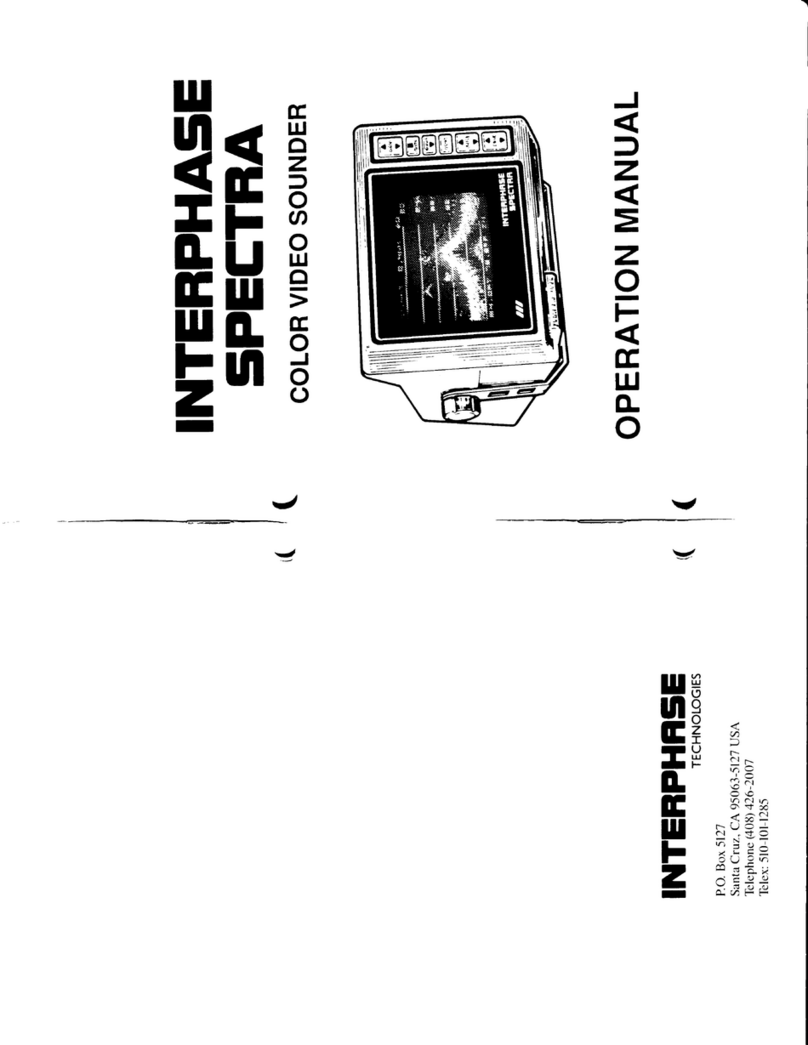
Interphase
Interphase Spectra User manual
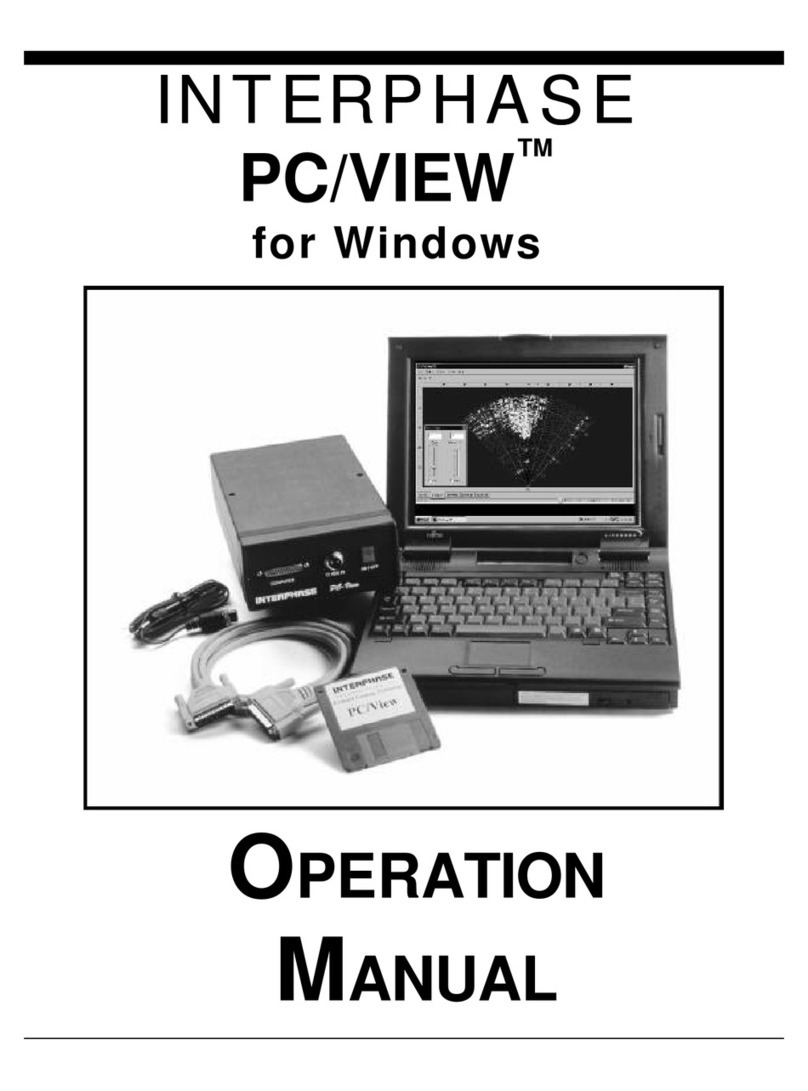
Interphase
Interphase PC/View User manual

Interphase
Interphase PC/180 User manual
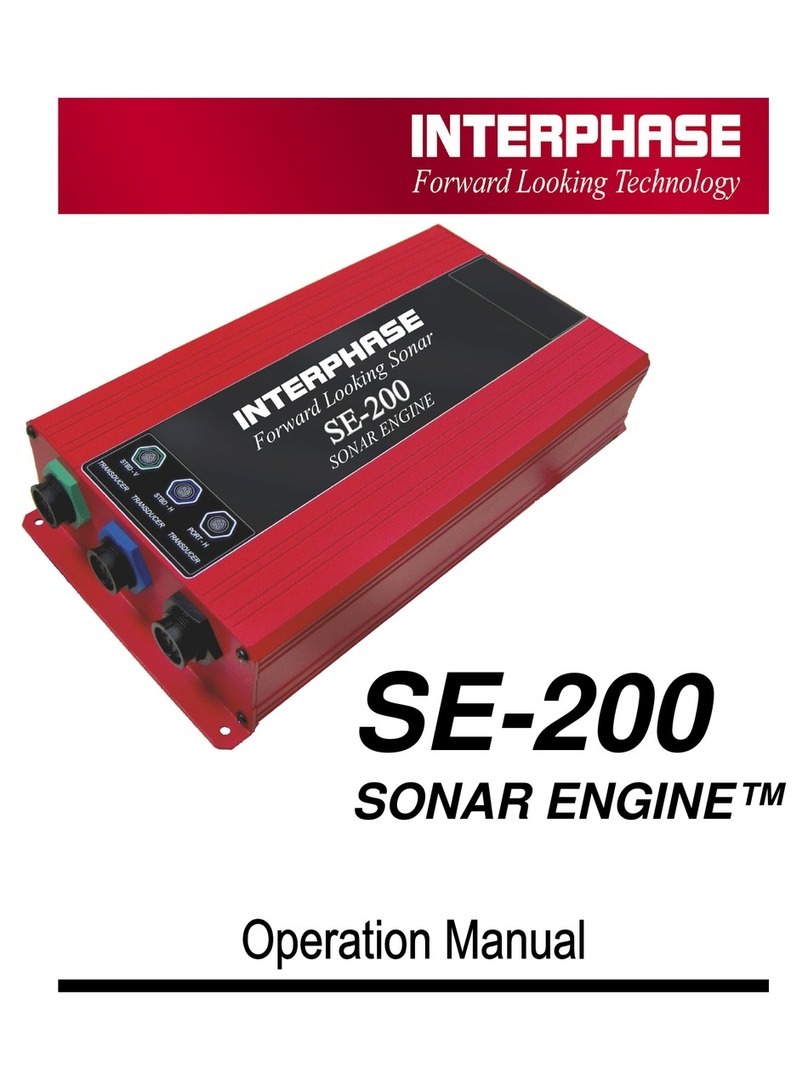
Interphase
Interphase Sonar Engine SE-200 User manual

Interphase
Interphase Advantage User manual
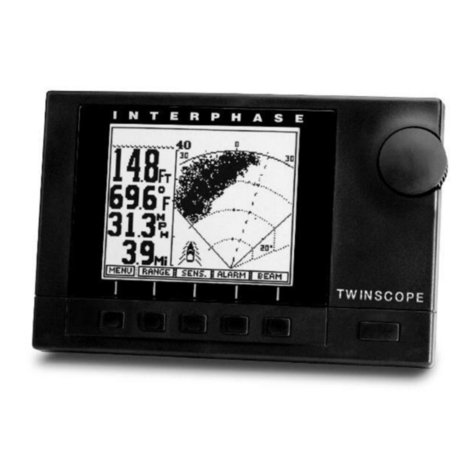
Interphase
Interphase Color Twinscope User manual

Interphase
Interphase PC/180 User manual
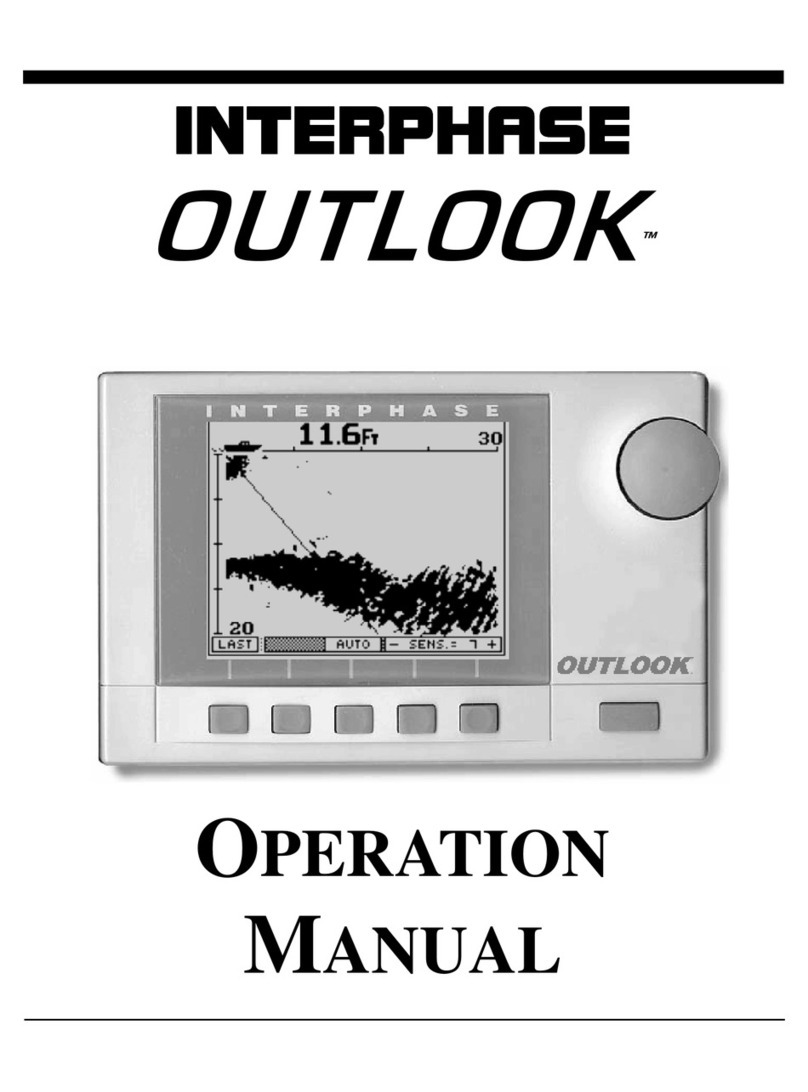
Interphase
Interphase Outlook User manual
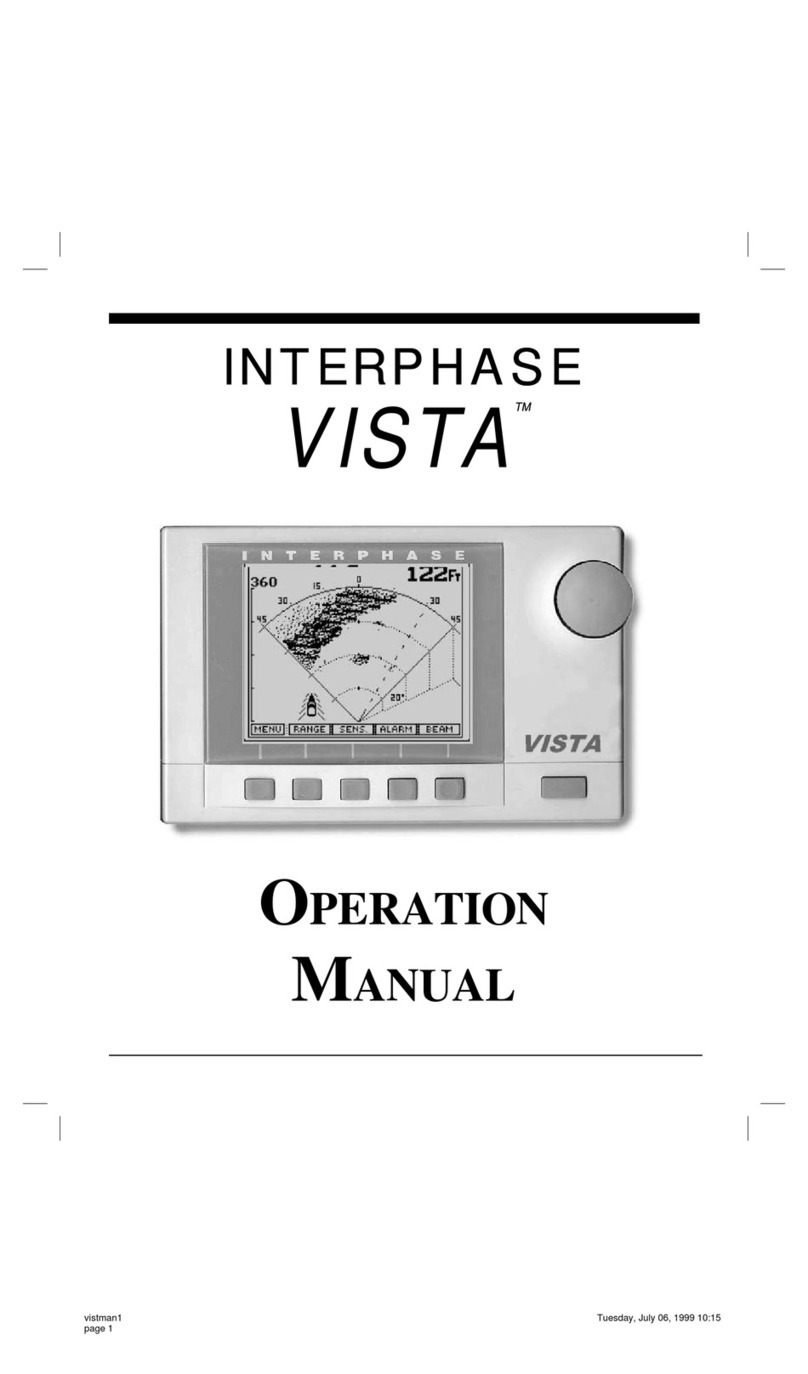
Interphase
Interphase Vista User manual
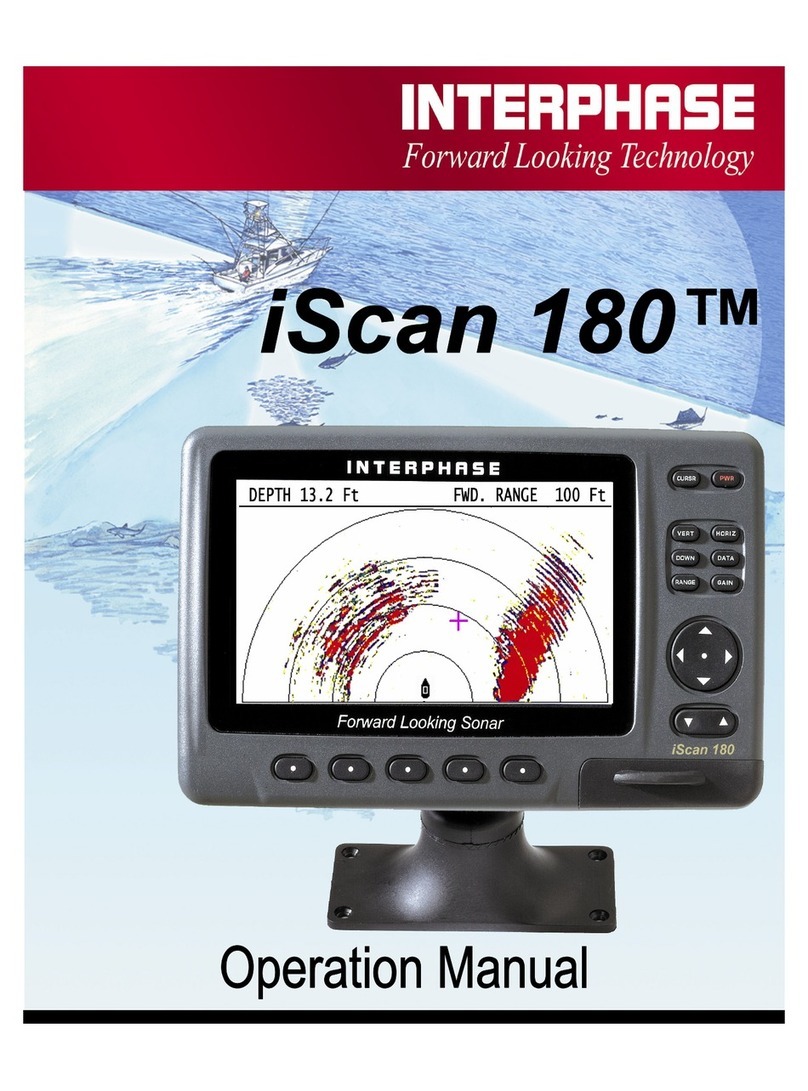
Interphase
Interphase 180 User manual

